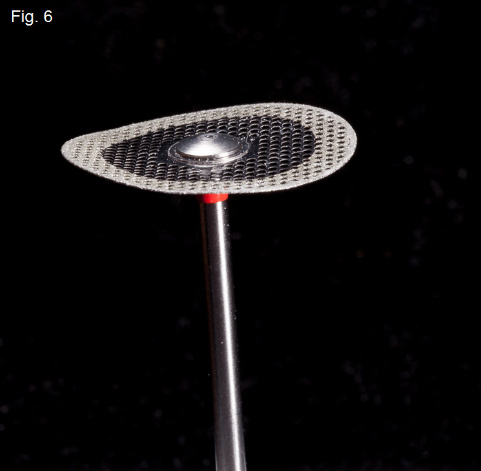Esthetics
Three Tips for Improved Embrasures with Provisional Restorations
By Darin Dichter on June 30, 2014 | 2 comments
The fabrication of a really nice provisional restoration is fundamental for indirect definitive restorations. Nice provisional restorations serve as a prototype for the definitive restorations, and they also provide the lab technician with the time necessary to do their best work. Good marginal seal and adequate gingival embrasure space are important considerations for biologic integration of the provisional, while natural labial and incisal embrasures are important for esthetic integration.
Refining the delicate interproximal areas of multi-unit provisionals is important; however, these areas are often difficult to access. Very thin, flexible discs can be the answer – here are three tips to help create the best results:
Close one eye
Closing one eye allows the operator to see clearly the plane the disc is rotating on, allowing for precise reduction with the sharp edge of the rotating disc. This is especially helpful while defining the outline form of the provisional. (Fig. 1-2)
 Slow down
Slow down
Slowing down the RPM of the lab motor allows greater control over the reduction and can reduce the incidence of a mishap. The flat side of the flexible disc can be used to contour the axial contours of the provisional. Running the disc at a lower speed allows for the disc to be pressed and flexed around the curves of the provisional without unduly flattening the contours – 8,000 to 10,000 RPMs are good starting values. (Fig. 3)
 Slow down even more
Slow down even more
For even greater control over subtle refinements, it is possible to remove the disc from the handpiece and use it manually, almost like very stiff sandpaper. Using the disk with a reciprocal motion allows for complete control, especially in the labial and incisal embrasures. (Fig. 4-5)
 A key advantage to this technique is that the disc does not have to be straight; therefore discs that have been damaged or bent during the course of their lifetime can be used. (Fig. 6)
A key advantage to this technique is that the disc does not have to be straight; therefore discs that have been damaged or bent during the course of their lifetime can be used. (Fig. 6)
 Putting in some extra effort will enhance esthetics and encourage healthy gingival tissues. Healthier gingiva means an easier insertion appointment and a more predictable result. I hope you find these tips useful. (Fig. 7-8)
Putting in some extra effort will enhance esthetics and encourage healthy gingival tissues. Healthier gingiva means an easier insertion appointment and a more predictable result. I hope you find these tips useful. (Fig. 7-8)
 Special thanks to Dr. Soo Jin Chang for her help with the photography in this article.
Special thanks to Dr. Soo Jin Chang for her help with the photography in this article.
Darin M. Dichter, DMD, Spear Resident Faculty
Refining the delicate interproximal areas of multi-unit provisionals is important; however, these areas are often difficult to access. Very thin, flexible discs can be the answer – here are three tips to help create the best results:
Close one eye
Closing one eye allows the operator to see clearly the plane the disc is rotating on, allowing for precise reduction with the sharp edge of the rotating disc. This is especially helpful while defining the outline form of the provisional. (Fig. 1-2)
 Slow down
Slow downSlowing down the RPM of the lab motor allows greater control over the reduction and can reduce the incidence of a mishap. The flat side of the flexible disc can be used to contour the axial contours of the provisional. Running the disc at a lower speed allows for the disc to be pressed and flexed around the curves of the provisional without unduly flattening the contours – 8,000 to 10,000 RPMs are good starting values. (Fig. 3)
 Slow down even more
Slow down even moreFor even greater control over subtle refinements, it is possible to remove the disc from the handpiece and use it manually, almost like very stiff sandpaper. Using the disk with a reciprocal motion allows for complete control, especially in the labial and incisal embrasures. (Fig. 4-5)
 A key advantage to this technique is that the disc does not have to be straight; therefore discs that have been damaged or bent during the course of their lifetime can be used. (Fig. 6)
A key advantage to this technique is that the disc does not have to be straight; therefore discs that have been damaged or bent during the course of their lifetime can be used. (Fig. 6) Putting in some extra effort will enhance esthetics and encourage healthy gingival tissues. Healthier gingiva means an easier insertion appointment and a more predictable result. I hope you find these tips useful. (Fig. 7-8)
Putting in some extra effort will enhance esthetics and encourage healthy gingival tissues. Healthier gingiva means an easier insertion appointment and a more predictable result. I hope you find these tips useful. (Fig. 7-8) Special thanks to Dr. Soo Jin Chang for her help with the photography in this article.
Special thanks to Dr. Soo Jin Chang for her help with the photography in this article.Darin M. Dichter, DMD, Spear Resident Faculty
Darin M. Dichter, DMD, Spear Visiting Faculty.
Comments
July 3rd, 2014
July 6th, 2014